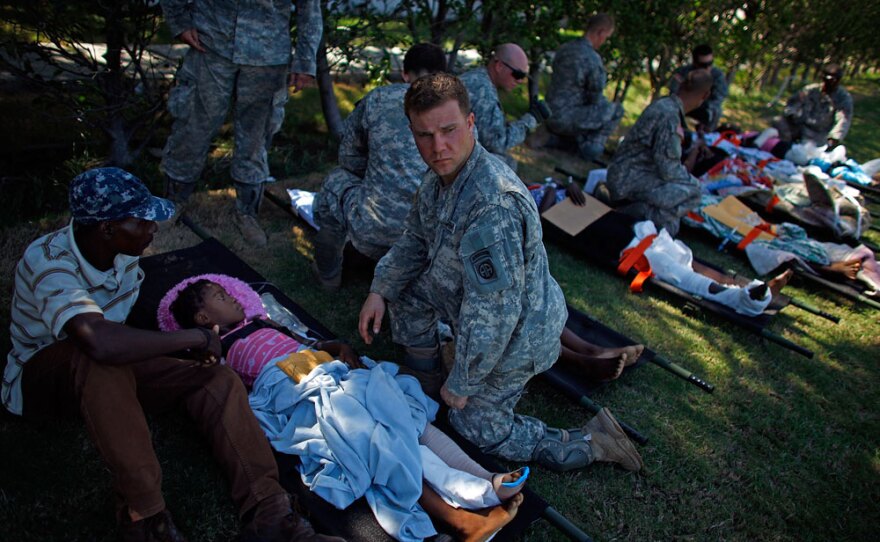Nobody knows how many wounded survivors there are in Haiti's earthquake zone. Medical relief people say tens of thousands — but that's an impressionistic guess.
However many there are, it's safe to say it's many, many times more than the number treated so far.
Take just one of the medical groups, Doctors Without Borders. It's one of the biggest medical teams on the ground in Haiti, and it was one of the first to set up after the quake because it already had a sizable presence there. Thursday night, Doctors Without Borders said it had treated about 5,000 survivors in its 10 hospitals — some of them shattered but stable buildings, others just tents. The group's surgeons have performed around 900 operations.
That's a lot of limbs amputated, broken bones set, infected wounds treated, lacerations sewn up. (Not to mention babies delivered.) But it's just a drop in the bucket.

"Our doctors think we probably have a backlog of 10 to 12 days' worth of surgery," says Jason Cone of Doctors Without Borders. "There's an incredible number of people who still need to have amputations done."
Partners in Health is one of the other large groups, with a dozen hospitals spread from Port-au-Prince to the central highlands near Haiti's border with the Dominican Republic. It's running 12 operating rooms around the clock at the central University Hospital in the capital.
Thursday, the patient load began to ease somewhat, as medevac helicopters began airlifting eight of the most severely injured trauma victims every hour — during the daylight hours — to the USNS Comfort hospital ship anchored offshore. The Comfort has treated about 230 patients so far, the U.S. government says.
Meanwhile, Meredith Eves of Partners in Health says the group's more remote facilities have been inundated by waves of injured patients fleeing Port-au-Prince. The group reports an urgent need for more antibiotics, anesthesia, pain medications, IV tubing and X-ray and anesthesia machines.
"Many hospitals I've talked to are running quite low on supplies," says Luke Beckman of the nonprofit group Innovative Support to Emergencies, Diseases and Disasters (InSTEDD).
An InSTEDD doctor who returned to the U.S. from Haiti on Thursday said the medicine most needed by physicians there is "ketamine, ketamine, ketamine" — an anesthetic.
Yet, oddly, not all the medical relief teams that have descended on Haiti in the past week are overwhelmed. In fact, the first U.S. government medical relief group to arrive — a Disaster Medical Assistance Team, or DMAT, from Massachusetts — is not very busy.
"They're not going as fast as they can," says NPR's Joanne Silberner, who is embedded with that DMAT group in a clinic in central Port-au-Prince that normally treats HIV/AIDS patients. "They could see more people. Not that many people have come because not that many people know about it."
Thursday night, the White House said the five DMAT teams deployed in Haiti have treated more than 7,000 patients.
The mismatch of medical demand and supply underscores a central problem right now that hobbles relief efforts — the total absence of communication and coordination.
No one is keeping track of what medical sites are operating and at what capacity, says Luke Beckman of InSTEDD. The problem is complicated by the fact that many makeshift medical facilities are moving from place to place, while new ones are popping up. The group is trying to establish a communications clearinghouse to match need with capacity.
Meanwhile, the Massachusetts DMAT team has been sending people out into the streets with bullhorns to spread the word. But medical care is not what most people wanted, says John Poole, an NPR videographer who went with them.
"Everybody was shouting back: 'We need food, we need water,' " Poole says. "There was absolutely nothing. No one was giving out anything. And this was right around the Presidential Palace, in downtown Port-au-Prince."
Poole says he began to feel woozy from walking around in the tropical sun, but felt he couldn't take a sip of water in sight of all those thirsty people. Some of them, he reports, were drinking "disgusting water" flowing out of roadside pipes.
U.S. military officials say they're beginning to hit their stride in the distribution of food and water. The USS Carl Vinson is producing 100,000 gallons of potable water daily, and water distribution sites have been set up in 45 locations on the island. The U.S. government is setting up nine water treatment units to provide enough clean water for 90,000 people a day. Meanwhile, deliveries of bottled water have been stepped up, the White House says.
Access to clean water will help reduce what public health experts expect to be the next wave of health problems among Haiti's earthquake survivors — diarrheal diseases and other infections due to the poor — or nonexistent — sanitation in makeshift camps where an estimated 1 million homeless people now gather.
Medical people also speak of another set of needs on the not-too-distant horizon: Thousands of amputees and fracture patients will soon need further care.
Xavier Lassalle of Doctors Without Borders points out that doing an amputation or setting a compound fracture is only the first step in a process.
"Providing for these surgical and medical needs will take months," Lassalle says. "Most of the wounded have infected wounds in their limbs, and they will have to undergo several cleaning operations ... then often orthopedic and reconstructive surgery."
It's unclear who will provide such help. Lassalle said emergency surgical teams that go into these disaster situations typically stay no more than a few weeks.
Copyright 2022 NPR. To see more, visit https://www.npr.org. 9(MDAzMjM2NDYzMDEyMzc1Njk5NjAxNzY3OQ001))







